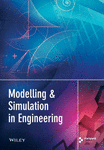Energy-Harvesting Cooperative NOMA in IOT Networks
Abstract
Buffer-aided cooperative nonorthogonal multiple access (NOMA) improves the effectiveness of the spectral by allowing more than one user to share the same resources to realize massive connectivity. This is notably attractive in the fifth generation (5G) and beyond systems, where a massive number of connections are essential such as the Internet of Things (IoT). Wireless-powered communication through energy harvesting is another 5G promising solution for the future massively dense networks. To sufficiently utilize energy harvesting in a buffer-aided cooperative NOMA network, the relay selection rule must consider the energy level of the selected relay in addition to its data content to avoid an outage. This paper proposes a relay selection rule for energy-harvesting buffer-aided cooperative NOMA networks. The proposed relay selection scheme considers the state of both the data buffer and the energy buffer. The simulations show that the proposed selection rule has improved the network outage probability and throughput as well. This enhancement is kept with changing the number of relays. The results also show that the impact of changing the energy buffer size is crucial, and the larger, the better. Furthermore, making the source transmitting power larger than the relay transmitting power is beneficial, especially with large enough energy buffer sizes.
1. Introduction
Currently, wireless connection is the most important form of communication; therefore, the unprecedented increase in the number of online devices makes wireless communications in upcoming applications more challenging. For example, the Internet of Things (IoT) (a fifth generation (5G) and beyond technology) requires massive wireless connectivity while maintaining a low outage probability, and these requirements cannot be met with the current infrastructure [1].
In traditional wireless communication, the main transmission form is the orthogonal transmission that ensures an exclusive frequency band, time slot, or code for each link between transmitters and receivers, to make sure that communications among different links do not interfere with each other. This transmission technique degrades the spectral efficiency and makes it insufficient for the forthcoming era of communications [2], resulting in the establishment of nonorthogonal multiple access (NOMA) for simultaneous use of the same resources. NOMA is conceptually different from orthogonal schemes; in NOMA, multiple users are allowed to transmit at the same code, time, and frequency, but with different levels of power. Particularly, NOMA gives lower power to the users with better channel states, because they can decode their own messages with less power and we call them the strong users. Due to the progression in the domain of signal processing, NOMA becomes realizable with advanced receivers, with which strong users can eliminate mutual interference caused by sharing the same resources by utilizing successive interference cancellation (SIC) [3]. Since higher power is sent to the weak user, the weak user (with the poor channel) can cancel the strong user signal (treating it as interference) and decode its signal successfully. Therefore, NOMA connects more users in the same resource such as frequency band or time slot, but with different levels of power which improves spectral efficiency [4]. Hence, NOMA is an attractive solution to achieve the massive connectivity required for 5G applications such as the IoT [5, 6]. Currently, NOMA is under consideration for 3GPP Release 16 standards of 5G systems [7].
Another essential network performance enhancement technique is relay [8]. Relays help the source to transmit packets to the users by providing an alternative connection between source and destination [9]. Based on that, LTE Release 10 has recognized the cooperation with relay nodes as an effective part of realizing modern wireless communications [10]. Relaying can be performed in two methods: amplify and forward (AF) and decode and forward (DF) [11, 12]. Relay selection is a key solution to avoid performance loss of cooperative relaying [13]. Early work selects relays aiming to maximize signal-to-noise ratio SNR [14]. Relay selection is extensively studied in the literature. We focus on those related to this study, particularly, buffer-aided relays. The idea behind buffer-aided relays is driven by the fact that the relay with the best channel for reception does not have to be the transmitting relay if it does not have the best transmission channel [15]. In [16], max–max relay selection (MMRS) selects the relay with the best-receiving channel in one slot and the relay with the best channel for transmission in the subsequent slot. The short back of MMRS is forcing transmission after reception. Max-link relay selection releases this constraint by selecting the best channel always [17]. Another improvement is the state-based scheme [18], where the data buffer state is considered in selection to avoid empty and full buffers. With an empty buffer, no transmission is possible and no reception with a full buffer.
Energy harvesting is appealing to avoid frequent battery change which increases the flexibility of relay deployment. By harvesting energy through solar or RF, a relay can charge itself. There are two methods to make efficient energy harvesting. In the first method, part of the received energy is for signal processing and the left is for transmission [19]. This is the popular simultaneous wireless information and power transfer (SWIPT). Another method is to store the harvested energy from the source signal in an energy buffer for future use.
After introducing these 5G technologies, it is noticeable that combining various technologies to overcome their shortcomings is popular in the literature. For example, NOMA has been successfully applied in buffer-aided cooperative relay networks. Several studies have applied the mentioned relay selection schemes with NOMA transmission and gained a better performance [20–22]. Another example of combining technologies is energy-harvesting buffer-aided relay networks. In [23], a relay is selected randomly from a set of relays with their energy buffers that are nonempty. The work in [24] considers both data buffer and energy buffer in relay selection; the authors assumed that relays harvest energy with energy arrivals according to a deterministic process. This is not practical; therefore, [25] considered a nondeterministic energy arrival and proposed a relay selection scheme based on the instantaneous state of both data buffers and energy buffers. As stated in [26], finding an optimal protocol that can achieve the minimum outage probability at a given delay constraint is still an open problem even in the most elementary buffer-aided relay network. As a result, the optimal selection scheme is still an open problem for relays with finite (practical) buffer size. Table 1 summarizes the related literature.
| Rule | Data buffer | Energy buffer | Data buffer state | Energy buffer state | Energy source | Multiple access |
|---|---|---|---|---|---|---|
| [16] | Infinite | X | X | X | Permanent | Orthogonal |
| [17] | Infinite | X | X | X | Permanent | Orthogonal |
| [18] | Finite | X | Available | X | Permanent | Orthogonal |
| [22] | Finite | X | Available | X | Permanent | Nonorthogonal |
| [23] | X | Finite | X | Available | RF | Orthogonal |
| [24] | Finite | Finite | Available | Available | RF | Orthogonal |
| [25] | Finite | Finite | Available | Available | RF | Orthogonal |
| This work | Finite | Finite | Available | Available | RF | Nonorthogonal |
However, to the best of the author’s knowledge, none of the available studies has suggested a relay selection scheme which is adequate for NOMA with energy harvesting in a random energy-arriving environment. Accordingly, motivated by filling this gap, the key novelty of this article is to propose a suitable relay selection scheme that minimizes the outage probability in a random energy-harvesting cooperative NOMA network by taking the state of data and energy buffers into consideration in the selection scheme. The contributions of this article are summarized as follows: (1) proposing a novel relay selection scheme for energy-harvesting buffer-aided cooperative NOMA networks, (2) studying the impact of varying the energy buffer size on the network outage probability, and (3) Studying the outage probability of the network under increasing the source transmitted power to give the relays the chance to gather more charges.
The rest of the article is organized as follows: the system model for the suggested energy-harvesting buffer-aided cooperative NOMA network is in Section 2. The proposed relay selection scheme and its performance analysis are presented in Section 3. Simulation trials of the proposed system along with comparison with other available solutions are discussed in detail in Section 4. Finally, the conclusion is presented in Section 5.
2. System Model
The system model of the proposed energy-harvesting buffer-aided cooperative NOMA network is shown in Figure 1. Figure 1 illustrates a source node S, k half-duplex DF buffer-aided relays, and k = 1, 2, 3.⋯, K, with R1 transmitting via NOMA to two users U1 and U2 simultaneously. The system model can be extended to any number of users as in [27]. The interconnection between relays in Figure 1 assures the balancing of data packets to avoid full and empty buffers.
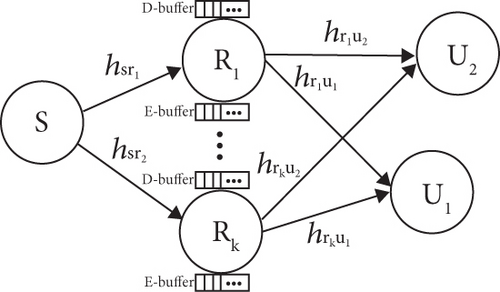
If the SNR for the Rk⟶Um (m = 1 or 2) links is not large enough to satisfy (12) or (13), NOMA transmission is not possible or not efficient. In this case, if , OMA can be used to transmit one packet to Um.
3. Proposed Relay Selection Scheme
With this scheme, the capability of the buffer-aided relay is fully exploited by releasing the necessity to make the receiving and the transmitting subsequent. In summary, from a practical production perspective, in the beginning, each relay sends its data and energy buffer length along with the channel state information (CSI) to the source node to decide on the relay selection. Then, the selected receiving relay stores the received packet in its data buffer from the source. The other relays harvest the energy from the source signal. Similarly, the selected transmitting relay sends a packet to the users by the energy in its energy buffer. To analyze the performance of the energy-harvesting relays in buffer-aided cooperative NOMA, we study the probability of selecting a transmitting relay; then, that relay can not send a data packet because of its empty energy buffer. That is, P({Rk|(Rk ∈ TS)∩(lk > 0)∩(ek = 0)}) ≥ 0 which increases the outage. This is likely to be the case because the most receiving relay or the relay with closer to a full buffer is likely to be the least energy-harvesting relay. Hence, the proposed selection scheme outperforms the available state-based scheme.
4. Simulation Results
This section presents the outcomes of the experimental simulations to confirm the proposed relay selection scheme. We test the validity of considering the energy buffer state in relay selection in the energy-harvesting cooperative NOMA network. In the simulations, we assume that the variance of the noise σ2 is normalized to unity and we follow [30] in assuming that data rate ε = 2 bps/Hz. The data and energy buffer size are set to L = 5, E = 5, unless stated otherwise. All simulation results are gathered with 106 Monte Carlo trials.
Firstly, we show the effect of considering the energy buffer state in relay selection on the NOMA network outage probability. The positive impact of this consideration on the outage probability is obvious in Figure 2. Figure 2 shows the comparison between selecting relays based on the state of the data buffer (the traditional state-based) and considering both data and energy buffer states in selection for the two relay NOMA networks. The proposed selection scheme enhances the network performance. This is the case because considering the energy buffer state in the selection scheme saves the network from being in outage by avoiding the selection of a transmitting relay with an empty energy buffer. For instance, to get a 0.3 outage probability in the two relay cases, the required SNR is about 11 dB and above 15 dB for the proposed and state-based selection scheme, respectively. So the reduction in the required SNR is more than 4 dB.
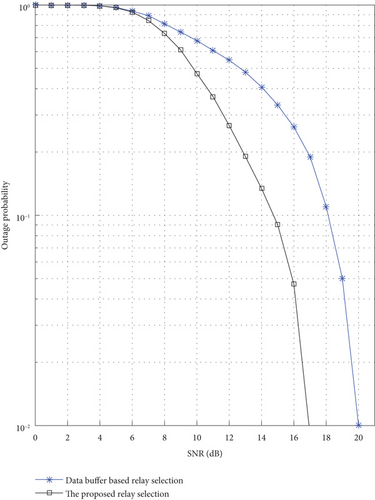
Figure 3 stresses the importance of the proposed selection scheme as it shows its impact on the throughput of the NOMA network. For the 2 relay case, the throughput improvement can be higher than 0.3 packets per time slot at 13 dB SNR. Based on the proportionality between outage probability and throughput, we can infer that the improvement in the outage performance by considering the energy buffer state will always raise the throughput of the network. This is the case with adding more relays; in Figure 4, the proposed scheme is applied in three relay networks, and it has enhanced the outage performance better than applying the proposed scheme in the two relay networks. It is worth mentioning that thanks to NOMA, reaching 1 packet per slot is possible with half-duplex transmission.
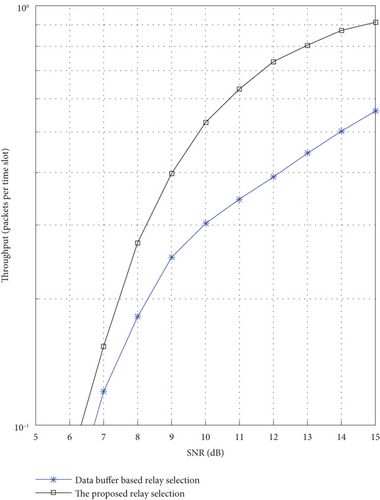
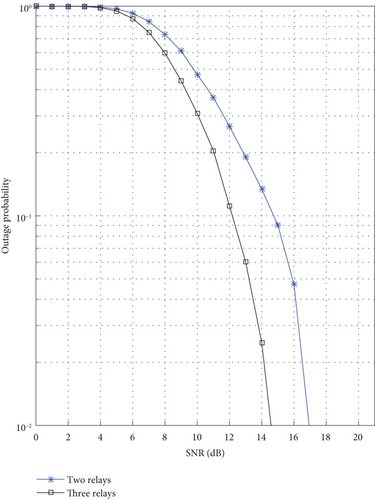
Another important aspect is the size of the energy buffer. The larger the size, the better in terms of outage probability; however, this is limited by the compactness of IoT devices. The impact of the energy sizes is shown in Figure 5. It is clear that with E = 1 (the smallest size), the performance of the three relay NOMA networks is the worst. This is due to the weak capabilities of the energy buffer in keeping charges. The performance is better with a larger energy buffer size; this is the case with E = 3 and E = 5. It is noticeable that the impact of increasing the size of the energy is weakened with larger sizes, so the difference in performance between E = 1 and E = 3 is much larger than the difference in performance between E = 3 and E = 5.
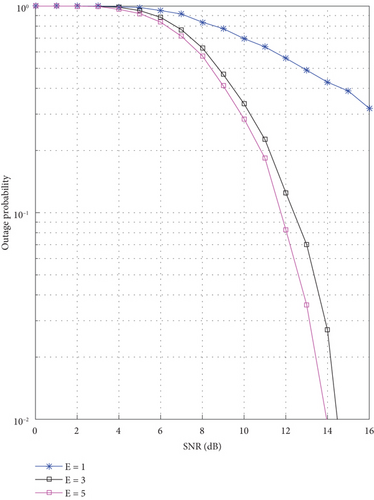
After studying the benefits of considering the energy buffer states in relay selection in NOMA networks, the impact of changing the transmitted power on the proposed scheme performance is shown in Figure 6. Three cases are considered: (1) the transmitted power from the source to the relays Pt is similar to the power of transmission from the relays to the users Pr. (2) Pt = 2Pr. (3) Pt = 4Pr. For example, the enhancement can reach 3 dB to achieve 0.3 outage probability with Pt = 4Pr when compared with Pt = Pr. The reason for this improvement is that with Pt = 4Pr if the relay received this power, its energy buffer will be charged in four slots. This means with one charging instance, the relay can transmit four times, which means more availability for the relay to users’ links. Before ending this section, it is noteworthy that the importance of large energy buffer size is increased. Specifically, it is known that the channel state changes from one-time slot to another, so it is important to keep the whole charge, especially with good channels. For instance, charging the relay with 4 slots in Pt = 4Pr is not possible if the energy buffer size is less than 4 E ≤ 4, with noting that charging the relay with 4 slots happens only with good channels which makes losing these charges pricey.
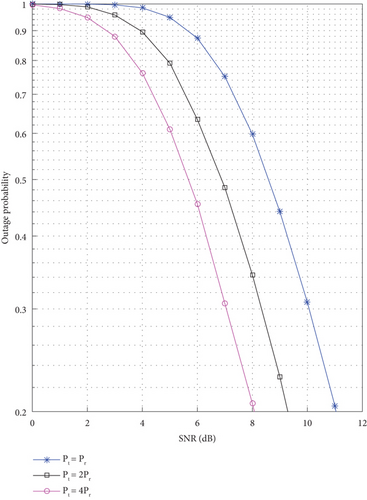
5. Conclusions
This study proposes considering the state of the energy buffer in relay selection in energy-harvesting buffer-aided cooperative NOMA networks. This is motivated due to the lack of performance caused by selecting a transmitting relay which is a lack of sufficient energy for transmission, which causes an outage. The proposed scheme improves the network performance by avoiding noncapable transmitting relays as this problem appears only with transmitting relays and not in the receiving ones. The improvements of the proposed scheme on the outage probability are valid even with adding more relays. The improvement in outage probability led to achieving higher throughput with the proposed scheme. Furthermore, the size of the energy buffer dictates the performance of the NOMA network; in general, the larger the value of E, the better. However, this value of E is limited to keep the compactness of devices. It is noticed that the impact of increasing the value of E is decreased with larger sizes. Finally, increasing the ratio of the source transmitting power and the relay transmitting power is beneficial in reducing the outage probability since it gives the relay the chance to harvest more energy, which increases the need for a large size energy buffer.
Conflicts of Interest
The author declares that there are no conflicts of interest.
Open Research
Data Availability
All required data are presented in the paper.



